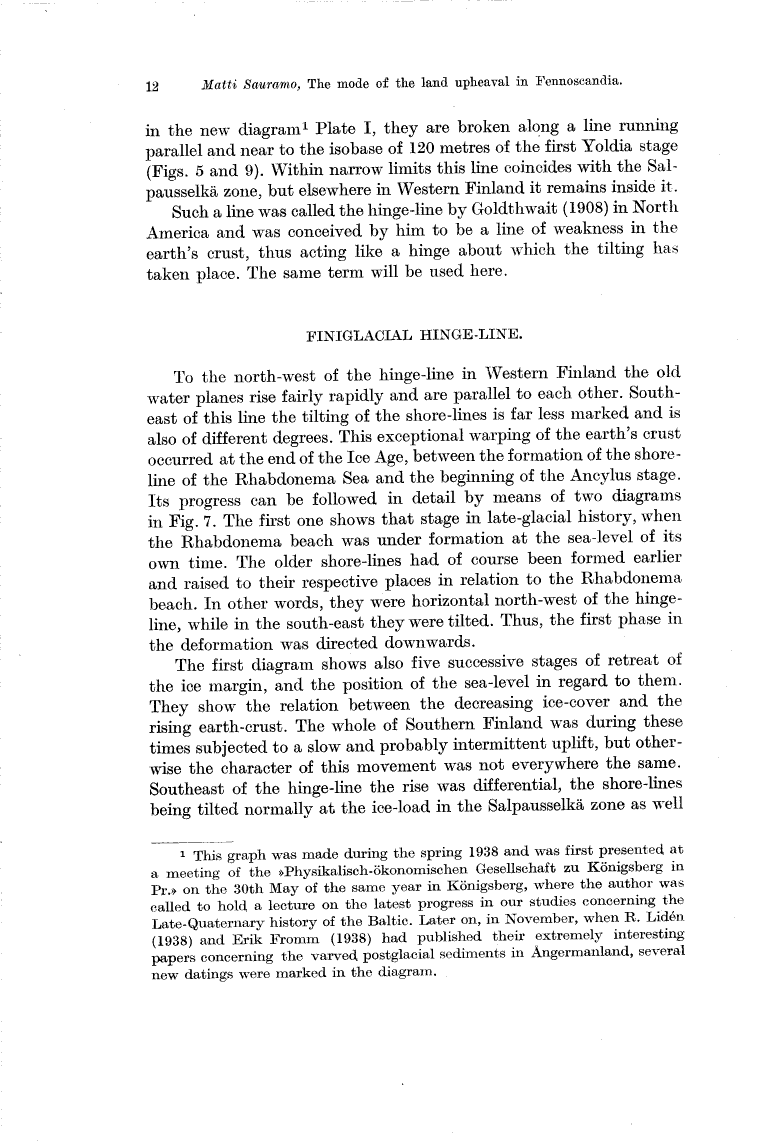
Full resolution (TIFF) - On this page / på denna sida - N:o 2 - Pages ...

<< prev. page << föreg. sida << >> nästa sida >> next page >>
Below is the raw OCR text
from the above scanned image.
Do you see an error? Proofread the page now!
Här nedan syns maskintolkade texten från faksimilbilden ovan.
Ser du något fel? Korrekturläs sidan nu!
This page has never been proofread. / Denna sida har aldrig korrekturlästs.
12
Matti Sauramo, The mode of the land upheaval in Fennoscandia.
in the new diagram1 Plate I, they are broken along a line running
parallel and near to the isobase of 120 metres of the first Yoldia stage
(Figs. 5 and 9). Within narrow limits this line coincides with the
Salpausselkä zone, but elsewhere in Western Finland it remains inside it.
Such a line was called the hinge-line by Goldthwait (1908) in North
America and was conceived by him to be a line of weakness in the
earth’s crust, thus acting like a hinge about which the tilting has
taken place. The same term will be used here.
FINIGLACIAL HINGE-LINE.
To the north-west of the hinge-line in Western Finland the old
water planes rise fairly rapidly and are parallel to each other.
Southeast of this line the tilting of the shore-lines is far less marked and is
also of different degrees. This exceptional warping of the earth’s crust
occurred at the end of the Ice Age, between the formation of the
shoreline of the Rhabdonema Sea and the beginning of the Ancylus stage.
Its progress can be followed in detail by means of two diagrams
in Fig. 7. The first one shows that stage in late-glacial history, when
the Rhabdonema beach was under formation at the sea-level of its
own time. The older shore-lines had of course been formed earlier
and raised to their respective places in relation to the Rhabdonema
beach. In other words, they were horizontal north-west of the
hinge-line, w hile in the south-east they were tilted. Thus, the first phase in
the deformation was directed downwards.
The first diagram shows also five successive stages of retreat of
the ice margin, and the position of the sea-level in regard to them.
They show the relation between the decreasing ice-cover and the
rising earth-crust. The whole of Southern Finland was during these
times subjected to a slow and probably intermittent uplift, but
otherwise the character of this movement was not everywhere the same.
Southeast of the hinge-line the rise was differential, the shore-lines
being tilted normally at the ice-load in the Salpausselkä zone as well
1 This graph was made during the spring 1938 and was first presented at
a meeting of the »Physikalisch-ökonomischen Gesellschaft zu Königsberg in
Pr.» on the 30th May of the same year in Königsberg, where the author was
called to hold a lecture on the latest progress in our studies concerning the
Late-Quaternary history of the Baltic. Later on, in November, when B. Lidén.
(1938) and Erik Fromm (1938) had published their extremely
interesting-papers concerning the varved postglacial sediments in Ångermanland, several
new datings were marked in the diagram.
<< prev. page << föreg. sida << >> nästa sida >> next page >>